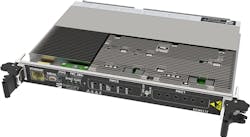Mercury’s launches new digitization transceiver
ANDOVER, Mass. - Mercury Systems, Inc. recently announced its new DCM6112 digitization transceiver, which balances low-latency and wide bandwidth for critical electronic warfare (EW) applications. Using the latest commercial semiconductor technology, Mercury’s new transceiver enables rapid deployment of directionally-accurate EW systems needed to counter the latest electromagnetic threats.
As threats increase in sophistication, EW systems must be able to process large amounts of information with minimal delay to mitigate emerging threats successfully. The DCM6112 transceiver uses the latest commercially-developed semiconductor technology combined with ruggedized military-grade packaging to minimize latency and maximize bandwidth, enabling EW systems to protect against increasingly complex threats. In addition to maximizing the performance of this digital transceiver, the modular architecture supports multiple DCM6112 modules in a fully scalable and coherent system.
The DCM6112 transceiver features four 12-bit analog-to-digital converter (ADC) channels as well as four 12-bit digital-to-analog (DAC) channels. All channels support a sample rate up to 3.2 gigasamples-per-second (GSPS). The real-time processing function consists of three Xilinx Kintex Ultrascale™ field-programmable gate array (FPGA) devices and one Xilinx Zynq Ultrascale FPGA to enable complex application-specific algorithms. The DCM6112 is compliant to the OpenVPX (VITA 65) open architecture standard and is available in either a front IO or rear IO configuration.
